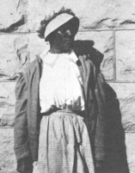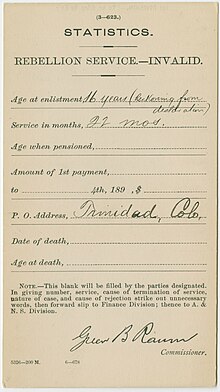Cathay Williams
Cathay Williams also William Cathay , or William Cathey (born September 1844 in Independence Missouri , † around 1893 in Trinidad , Colorado ) was an American soldier in the United States Army under the pseudonym William Cathay . She was the first African American woman to serve in arms and the only one documented to serve as a man.
Life
Cathay Williams was born to an enslaved mother and free father in Independence, Missouri. Due to her mother's status, she was also considered a slave. As an adolescent, she worked as a house slave on Johnson Plantation, which belonged to the wealthy planter William Johnson and was in the rural Jefferson City area , until his death. When Union Forces occupied Jefferson City in the early stages of the Civil War in 1861 , she was liberated and worked as a paid helper with military support duties for the Union Army. At the age of 17 she served as a cook and laundress and accompanied the infantry troops across the country. She served under Col. Thomas Hart Benton and witnessed the Battle of Little Rock, Arkansas, as well as General Philip Sheridan and witnessed the Battle of Pea Ridge .
Entry into the army
On November 15, 1866, Williams volunteered for the Army, a rising black regiment that later became part of the Buffalo Soldiers . She posed as a man and took the name William Cathay . She signed up for a three-year service and was assigned to the 38th US Infantry Regiment. She passed the military entrance examination and it was not recognized that she was a woman. On February 13, 1867, Williams was sent to Jefferson Barracks, Missouri, and a few months later, in April, the troops marched on Fort Riley , Kansas. They were on their way again in June, this time to Fort Harker , Kansas, and the next month to Fort Union , New Mexico, more than half a mile away. On September 7th, the regiment moved to Fort Cummings , New Mexico, and arrived on October 1st. They were stationed there for eight months to protect miners and traveling immigrants from the Apache attacks.
Shortly after joining the army, she contracted smallpox and was admitted to hospital. After the illness subsided, she returned to her unit in New Mexico. She suffered from poor health, possibly due to smallpox, the heat, or years of marching, and had to seek medical attention more often. Her unit marched to Fort Bayard , New Mexico on June 6, 1868 , and was admitted to Fort Bayard Hospital on July 13. This time neuralgia was diagnosed. On October 14, 1868, William Cathey was honorably discharged from service after it was discovered that she was a woman. In addition, she was certified that she had been under the command of her commanding officer, Captain Charles E. Clarke, since May 20, 1867, who stated that she was in poor health, had been continuously ill and had not performed. The doctor on duty confirmed this and stated that she was unable to do military service and that this condition existed before she joined the army.
Williams participated in regular garrison services, was trained on the musket , and learned to perform guard and reconnaissance missions. However, there is no record of her ever participating in direct combat during her service. There is also no evidence that she was an exceptional soldier, but there is evidence that she did her job perfectly. Though she was apparently not greatly appreciated by her commanding officer, she was dismissed with the legacy of having been the first and only female Buffalo Soldier.
After the army
After her discharge from the army, Williams worked as a cook in Fort Union, New Mexico, from 1869 to 1870, and later moved to Pueblo, Colorado and worked as a laundress. There she married, but her husband left her and took her money and horses with him. Williams had him arrested and moved to Trinidad, Colorado in 1872. There she also worked as a laundress and sometimes as a nurse. A St. Louis reporter learned of rumors about an African American woman who had served in the Army and went to see her to interview her. Her story became known and published in the St. Louis Daily Times on January 2, 1876.
Her health was not good and in early 1890 she was hospitalized for almost a year and a half. When she left the hospital she was penniless and in June 1891 she applied for a US Army pension. In her application, she stated that she suffered from deafness, rheumatism and neuralgia, which she suffered from during her military service. After various medical examinations, however, the pension authority rejected her application on the grounds that there was no disability. It was also found that her notice of dismissal from service indicated that her illnesses existed before she joined the army. Finally, and most obviously, her service in the army was not legal and any kind of pension, disability or otherwise, was denied. This despite the precedent for granting a pension to female soldiers such as the one paid to Deborah Sampson , Anna Maria Lane and Molly Williams , who also disguised and served as men during the Revolutionary War.
In September 1893 a doctor examined Williams. She suffered from neuralgia and diabetes, and all of her toes had been amputated. She could only walk with a crutch. The exact time of her death is not known. However, since she is no longer mentioned in the 1900 census, she will have died before 1900.
Cathay Williams became the first African American woman to serve as the only documented woman in the United States Army, despite disguised as a man. Williams is also the only known female Buffalo Soldier.
Web links
- Cathay Williams in the database of Find a Grave (English)
Individual evidence
- ↑ a b c d e f Cathay Williams - Female Buffalo Soldier - Legends of America. In: legendsofamerica.com. Retrieved July 14, 2019 .
- ↑ a b c d e f g h Cathay Williams (US National Park Service). In: nps.gov. Accessed July 14, 2019 .
- ^ A b Cathay Williams Biography at Black History Now. In: blackhistorynow.com. Retrieved July 14, 2019 (American English).
| personal data | |
|---|---|
| SURNAME | Williams, Cathay |
| ALTERNATIVE NAMES | Cathay, William; Cathey, Wiliam |
| BRIEF DESCRIPTION | American soldier |
| DATE OF BIRTH | September 1844 |
| PLACE OF BIRTH | Independence Missouri |
| DATE OF DEATH | around 1893 |
| Place of death | Trinidad , Colorado |

